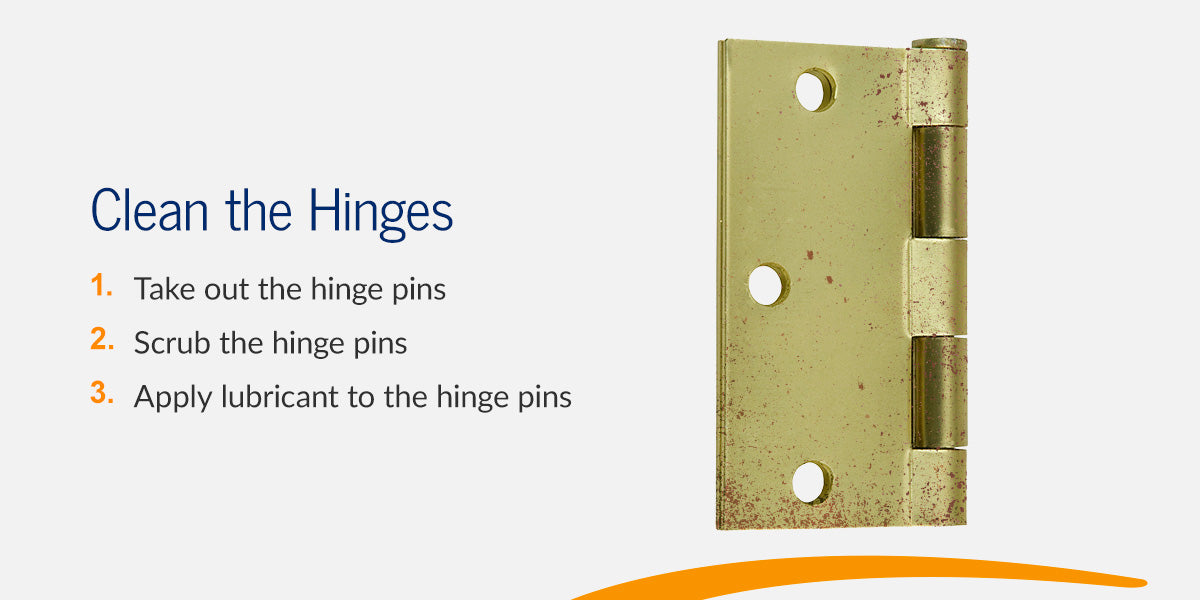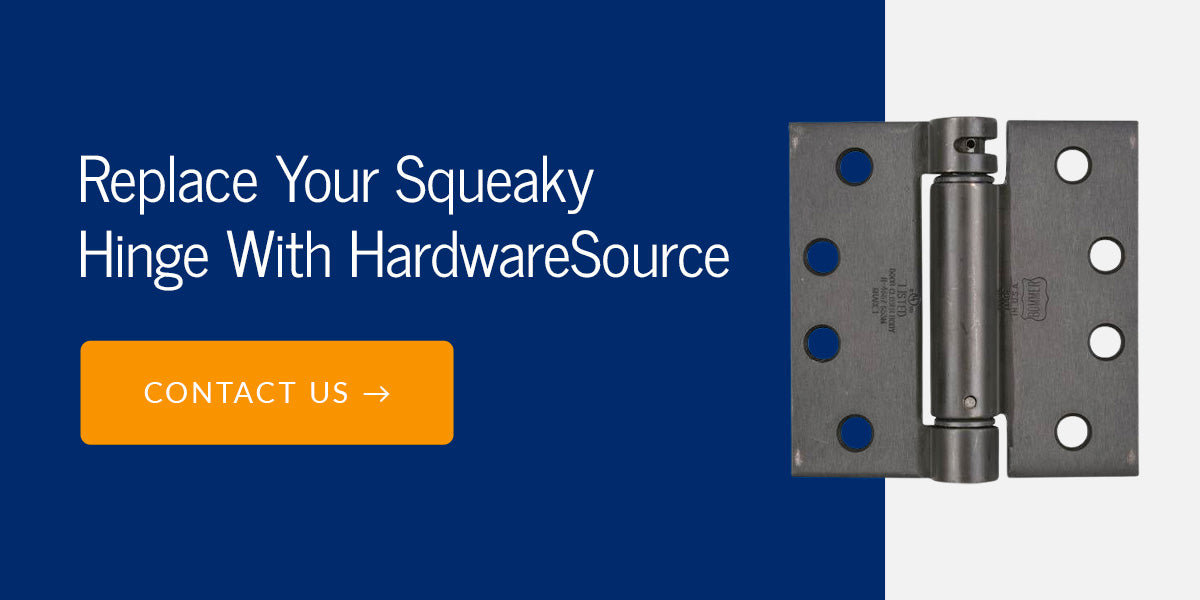
Doors open and close many times a day, and when you have squeaky hinges, you’re constantly reminded that you need to fix them. Squeaky hinges are enough to send some homeowners over the edge. Thankfully, this guide provides both basic and unusual ways to silence those hinges once and for all. In this guide, you’ll discover what causes squeaky hinges and five effective ways to stop squeaky door hinges.
What Causes Squeaky Hinges?
Hinges start squeaking for many reasons. In some cases, there is little space between the door and the door jamb, causing the wood of the door and the door frame to rub against each other. In other, more common cases, the hinges squeak simply due to wear or settling. Understanding why the hinge is squeaking can help you decide on the best course of action to stop it. Here are four of the most common reasons your hinge might be squeaking:
- Damaged pins: Hinges may squeak when a pin is damaged or bent. Often, pins become warped due to incorrect handling when removing them. Once back inside the knuckle, the bent pin will rub against the hinge’s leaf, causing a squeaky sound.
- Friction: With too little lubrication, your hinges will be susceptible to friction and create squeaky noises. By properly lubricating your hinges, you ensure its pins will be able to move smoothly.
- Dirt or debris inside the knuckle: Sometimes dirt or debris will accumulate inside the knuckle and restrict the hinge’s movement, causing the hinge to squeak when opening and closing the door.
- Type of hinge knuckle: A squeaky hinge might also result from the type of hinge knuckle — plain bearing hinge knuckles rub metal on metal, while ball-bearing hinges often squeak less because the bearing raceways separate the knuckles.
Ways to Avoid a Squeaky Hinge

Adding lubricant is often the first solution homeowners try when attempting to fix a squeaky hinge. However, lubricant isn’t always the best option. For example, if your hinge has built-up grime and dirt, lubricant will only solve the issue temporarily. Let’s explore five different ways to stop squeaky door hinges.
1. Apply Lubricant
One of the fastest ways to fix squeaky hinges is by applying a lubricant. We recommend using dry lubricant rather than liquid lubricant. With liquid lubricants, it’s easy for the substance to drip onto the jamb, floor, door, or wall. A dry lubricant will prevent your hinge from squeaking for a few weeks. Here’s how to apply lubricant:
- Remove the hinge pins: Close the door and locate the hinge pin. Using a punch tool and hammer, carefully tap the base of the pin to free and pry it out. You can also lubricate the hinge pin without removing it entirely if that fixes the squeak.
- Coat the hinge pins with lubricant: Coat the hinge pin as best you can with the lubricant and wipe away any excess with a spare rag. If you choose to use a liquid lubricant, be careful to leave only a thin film to avoid mess.
- Place the pin back inside the hinge: Once the pin is steady, tap it back into the hinge carefully with a hammer, and then open and shut the door a few times to ensure the squeak is gone.
Although we recommend sticking with a dry lubricant, you could use a dab of oil, dish soap, or grease. If you end up removing the hinges, you can also rub hot wax from a paraffin candle onto the hinge before reinstalling them. Keep a spare rag within reach for cleaning up.
2. Clean the Hinges

In some cases, your squeaky hinges might be the result of dirt, rust, or grime that has built up inside the hinges. The best call would be to clean the hinges and then lubricate them. Here’s a step-by-step process for cleaning your squeaky door hinges:
- Take out the hinge pins: Try loosening each hinge pin on the squeaky door by tapping from underneath with a hammer or mallet. You can use a 16d or similarly sized nail if the hinge pin is stuck or particularly difficult to tap loose. Once the hinge pin is loose, pull it up and out of the hinge. Lift up the door handle to relieve any pressure if the pin should happen to bind. Keep the door closed and work on one hinge at a time.
- Scrub the hinge pins: Once the hinge pin is free, scrub the hinge pin with steel wool or a toothbrush in small circular motions to remove any rust, dirt, or paint. You can even add some diluted household cleaners to get rid of stubborn dirt.
- Apply lubricant to the hinge pins: Once the hinge pins are clean, we recommend lubricating them with melted wax or a dry spray lubricant. Otherwise, you may use oil, dish soap, or grease if you are unable to procure a dry lubricant. Reinsert the hinge pin, reassemble the hinges, and reinstall the door to its position. Finish the job by testing the hinges for squeaks and wiping away any excess lubricant.
3. Tighten Loose Screws
Another common reason for squeaky hinges is loose screws. You can easily fix squeaky hinges by tightening the screws. You may need to adjust the door hinge if the squeaking is still there.
To tighten the screws, loosen and remove them from the hinges with a screwdriver. Once they are loose, you can adjust the door as needed until it’s in the correct resting position and does not rub against any surfaces while opening and closing. Then, you can tighten the screws on the hinges until they are secure again.
4. Replace Damaged Hinges

If you’ve tried all the above steps and your hinges are still squeaking, they may be trying to tell you that it’s time for a replacement. By replacing the old with the new, you will not only improve the functionality of your door but also add beauty and consistency to your home. There are a wide variety of hardware finishes to choose from, which gives you the freedom to experiment until your vision has turned into a reality.
The hinges you choose should depend on the item you’ll be attaching them to. Is it a door? Is it a cabinet? Here are a few types of hinges you can consider to minimize the chance of squeaking later on:
- Door hinges: When considering which door hinge to purchase, ensure that they’re of good quality and match your current hinge size. You can do this by measuring the size of your hinge from side to side and from bottom to top.
- Cabinet hinges: There are four main types of cabinet hinges to choose from, including offset, overlay, full inset, and partial inset. The offset hinge is surface-mounted and fully visible, the overlay covers the cabinet opening, the full inset sits in the cabinet opening, and the partial inset is required when the door fits inside the cabinet opening.
- Gate hinges: If you’re looking to replace your gate hinges, consider the different types to ensure they are the correct fit and style. There are various gate hinge types, including spring hinges, surface-mounted hinges, pintle hinges, heavy-duty hinges, and butt hinge varieties.
- Window and shutter hinges: Window and shutter hinges can be unique, so your best solution is to replace them with an exact match. Be sure to browse some window and shutter hinges online to find ones that match your specific needs.
- Specialty hinges: There are also different types of specialty hinges. Some examples may include roller-bearing hinges, weld-on spring hinges, brass ball-tipped hinges, or surface-mounted spring hinges.
Replace Your Squeaky Hinge With HardwareSource
As a homeowner, it’s essential to know how to avoid squeaky door hinges so you can save money on calling an expert to do it for you. If your door hinges are still squeaking after taking the above precautions, we recommend replacing your door hinges with a company that can offer you quality hinges that last. HardwareSource offers a wide selection of hinges and finishes, including brass, bronze, chrome, nickel, pewter, stainless steel, and zinc.
With over 4,000 hinges in stock and ready to ship, we’re an excellent solution for your home improvement project. Shop our door, cabinet, window, and gate hinges and other hardware products on our website, or use our hinge finder to make finding your hinge size easier!

